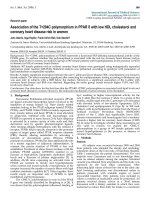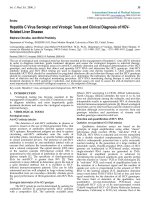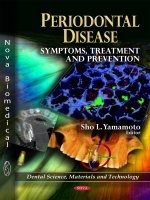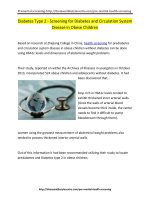Genes and disease
Bạn đang xem bản rút gọn của tài liệu. Xem và tải ngay bản đầy đủ của tài liệu tại đây (3.9 MB, 236 trang )
National Center for Biotechnology Information (US)
Genes and Disease
Last Updated: 2011 Jan 31
National Center for Biotechnology Information (US)
Bethesda (MD)
National Center for Biotechnology Information (US), Bethesda (MD)
NLM Citation: National Center for Biotechnology Information (US). Genes and Disease [Internet].
Bethesda (MD): National Center for Biotechnology Information (US); 1998-.
iii
Genes and Disease is a collection of articles that discuss genes and the
diseases that they cause. These genetic disorders are organized by the
parts of the body that they affect. As some diseases affect various
body systems, they appear in more than one chapter.
With each genetic disorder, the underlying mutation(s) is discussed,
along with clinical features and links to key websites.
iv
Genes and Disease
Table of Contents
Introduction to Genes and Disease ......................................................................................................................
v
Blood and Lymph Diseases ....................................................................................................................................
1
Cancers.......................................................................................................................................................................
3
The Digestive System ...............................................................................................................................................
5
Ear, Nose, and Throat.............................................................................................................................................
7
Diseases of the Eye ..................................................................................................................................................
9
Female-Specific Diseases........................................................................................................................................ 11
Glands and Hormones............................................................................................................................................ 13
The Heart and Blood Vessels ................................................................................................................................. 15
Diseases of the Immune System ............................................................................................................................ 17
Male-Specific Diseases ........................................................................................................................................... 19
Muscle and Bone...................................................................................................................................................... 21
Neonatal Diseases ................................................................................................................................................... 23
The Nervous System ................................................................................................................................................ 25
Nutritional and Metabolic Diseases..................................................................................................................... 29
Respiratory Diseases ............................................................................................................................................... 33
Skin and Connective Tissue.................................................................................................................................... 35
Chromosome Map ................................................................................................................................................... 37
v
Introduction to Genes and Disease
Genes and Disease is a collection of articles that discuss genes and the diseases that they
cause. These genetic disorders are organized by the parts of the body that they affect. As
some diseases affect various body systems, they appear in more than one chapter.
With each genetic disorder, the underlying mutation(s) is discussed, along with clinical
features and links to key websites. You can browse through the articles online, and you
can also download a printable file (PDF) of each chapter.
From Genes and Disease you can delve into many online related resources with free and
full access. For example, you can visit the human genome to see the location of the genes
implicated in each disorder. You can also find related gene sequences in different
organisms. And for the very latest information, you can search for complete research
articles, and look in other books in the NCBI Bookshelf.
Currently over 80 genetic disorders have been summarized, and the content of Genes and
Disease is continually growing. Your ideas and suggestions are welcome. You can contact
us at:
Preface
vi
Genes and Disease
The sequence of the human genome is providing us with the first holistic view of our
genetic heritage. While not yet complete, continued refinement of the data bring us ever
closer to a complete human genome reference sequence. This will be a fundamental
resource in future biomedical research.
The 46 human chromosomes (22 pairs of autosomal chromosomes and 2 sex
chromosomes) between them house almost 3 billion base pairs of DNA that contains
about 30,000 - 40,000 protein-coding genes. The coding regions make up less than 5% of
the genome (the function of the remaining DNA is not clear) and some chromosomes
have a higher density of genes than others.
Most of the genetic disorders featured on this web site are the direct result of a mutation
in one gene. However, one of the most difficult problems ahead is to find out how genes
contribute to diseases that have a complex pattern of inheritance, such as in the cases of
diabetes, asthma, cancer and mental illness. In all these cases, no one gene has the yes/no
power to say whether a person has a disease or not. It is likely that more than one
mutation is required before the disease is manifest, and a number of genes may each make
a subtle contribution to a person's susceptibility to a disease; genes may also affect how a
person reacts to environmental factors. Unraveling these networks of events will
undoubtedly be a challenge for some time to come, and will be amply assisted by the
availability of the sequence of the human genome.
1
Blood and Lymph Diseases
2
Genes and Disease
As most of the cells in the human body are not in direct contact with the external
environment, the circulatory system acts as a transport system for these cells. Two distinct
fluids move through the circulatory system: blood and lymph. Blood carries oxygen and
nutrients to the body's cells, and carries waste materials away. Blood also carries
hormones, which control body processes, and antibodies, to fight invading germs. The
heart is the pump that keeps this transport system moving. Together, the blood, heart, and
blood vessels form the circulatory system.
The lymphatic system (lymph, lymph nodes and lymph vessels) supports the circulatory
system by draining excess fluids and proteins from tissues back into the bloodstream,
thereby preventing tissue swelling. It also serves as a defense system for the body, filtering
out organisms that cause disease, producing white blood cells, and generating antibodies.
The biochemical make up of lymph — the fluid found in the lymphatic vessels — varies
with the site of origin. For example, lymph from bone marrow, spleen, and thymus have
high concentrations of white blood cells for fighting infection, while lymph from
intestines is high in fat that has been absorbed during digestion. Damage to the lymphatic
and circulatory systems leaves the body more susceptible to sickness and infection, as well
as to serious conditions such as cancer.
Diseases
Anemia, sickle cell
Burkitt lymphoma
Gaucher disease
Hemophilia A
Leukemia, chronic myeloid
Niemann-Pick disease
Paroxysmal nocturnal hemoglobinuria
Porphyria
Thalassemia
Did you know ...?
"Elephantiasis" occurs after years of infection of the lymph vessels with parasites. Lymph
fluid accumulates causing massive swelling of the legs.
Scientists once thought that all blood was the same, leading to deadly blood transfusion
reactions.
3
Cancers
Cancer occurs when cell division gets out of control. Usually, the timing of cell division is
under strict constraint, involving a network of signals that work together to say when a
cell can divide, how often it should happen and how errors can be fixed. Mutations in one
or more of the nodes in this network can trigger cancer, be it through exposure to some
environmental factor (e.g. tobacco smoke) or because of a genetic predisposition, or both.
Usually, several cancer-promoting factors have to add up before a person will develop a
malignant growth: with some exceptions, no one risk alone is sufficient.
The predominant mechanisms for the cancers featured here are (i) impairment of a DNA
repair pathway (ii) the transformation of a normal gene into an oncogene and (iii) the
malfunction of a tumor supressor gene.
Diseases
Breast and ovarian cancer
Burkitt lymphoma
Colon cancer
Leukemia, chronic myeloid
Lung carcinoma, small cell
Malignant melanoma
4
Genes and Disease
Multiple endocrine neoplasia
Neurofibromatosis
The p53 tumor suppressor protein
Pancreatic cancer
Polycystic kidney disease
Prostate cancer
Harvey Ras oncogene
Retinoblastoma
Tuberous sclerosis
Von Hippel-Lindau syndrome
Did you know ...?
Is cancer the leading cause of death in Americans? Or is it heart disease, stroke, or
accidental injuries?
5
The Digestive System
Digestion is the process of turning food into fuel for energy, and for maintenance of the
body structure. The digestive tract is a series of hollow organs joined in a long, twisting
tube from the mouth to the anus. Inside this tube is a lining called the mucosa. In the
mouth, stomach, and small intestine, the mucosa contains tiny glands that produce
enzymes to help digest food. There are also two solid digestive organs, the liver and the
pancreas, which produce enzymes that reach the intestine through small tubes.
During the digestive process, food passes down the throat, through the esophagus, and
into the stomach, where food continues to be broken down. The partially digested food
passes into a short tube called the duodenum — the first part of the small intestine. The
jejunum and ileum are also part of the small intestine. The liver, the gallbladder, and the
pancreas produce enzymes and substances to help with digestion in the small intestine.
6
Genes and Disease
After the digestive process is complete, the resulting waste travels downstream to the
colon. The colon and rectum are parts of the body's digestive system, which removes
nutrients from food and stores waste until it passes out of the body. Together, the colon
and rectum form a long, muscular tube called the large intestine.
The health of your digestive system has a lot to do with lifestyle — the food you eat, the
amount of exercise you get, and the pace and stress level of your day. However, some
digestive diseases, such as those discussed here, are thought to be hereditary or stem from
an infection. For others, there is no known cause.
Diseases
Colon cancer
Crohn's disease
Cystic fibrosis
Diabetes, type 1
Glucose galactose malabsorption
Pancreatic cancer
Wilson's disease
Zellweger syndrome
Did you know ...?
Millions of bacteria colonize the walls of our gastrointestinal tracts.
7
Ear, Nose, and Throat
Within the structures of the ear, nose and throat are complex and interrelated
mechanisms that allow a person to make sound, hear, maintain balance, smell, breathe,
and swallow. Traditionally, treatment of the ear — otology — was associated with that of
the eye in medical practice. With the development of laryngology — the study of the
throat — in the late 19th century, the connection between the ear and throat became
known. Thus the birth of a discipline called otolaryngology.
Many people associate otolaryngologists with the treatment of ear infections, hearing loss
and sinus problems. Otolaryngology actually encompasses the treatment of many diverse
conditions, including: dizziness, facial plastic and reconstructive surgery, head and neck
cancer, hearing loss, problems of the larynx and sinus, difficulties swallowing, tumors of
the auditory nerve, and voice production.
8
Genes and Disease
When diagnosing ear, nose, and throat disorders, it is important to differentiate genetic
disorders from those due to environmental influences. This is often difficult as similar
clinical features may be produced by different environmental factors or by different genes
or groups of genes.
Diseases
Deafness
Neurofibromatosis
Pendred syndrome
Did you know ...?
The number of people training to be otolaryngologists in the United States has doubled
since 1975. Find out more ...
9
Diseases of the Eye
The function of our eyes is to allow us to see the objects in our surroundings at variable
distances and under various conditions of lights. This function is achieved by a very
complex arrangement of layers and structures found in the eye. In addition, two pockets
of transparent fluid — the aqueous and vitreous humors — nourish eye tissues and help
maintain constant eye shape.
10
Genes and Disease
The eye is comprised of three layers: an outer protective white coating called the sclera; a
middle layer (choroid) containing blood vessels which nourish the eye; and an inner layer
(retina) which contains the nerves that bear information to the brain for processing.
The cornea is the clear portion found at the front of the eye and serves to bend light rays.
The iris, an extension of the choroid, is the colored portion of the eye and is made up of a
spongy tissue. The pupil (black) is an opening in the iris that allows light into the eye. The
lens then helps focus the light rays onto photoreceptors, which absorb and convert the
light into electrical signals that carry information. The optic nerve contains fibers that
transmit these signals to the brain for interpretation of the objects seen.
With the recent advances in molecular genetic techniques, new genes that cause eye
disease are rapidly being identified, such as for those diseases discussed here. In many
instances, these findings allow researchers to develop innovative strategies for preventing
or slowing the progress of genetic eye diseases.
Diseases
Best disease
Glaucoma
Gyrate atrophy of the choroid and retina
Retinoblastoma
Did you know ...?
Everyone has a blind spot, to find yours, do this test (you can use the mouse cursor
instead of a pencil)...
11
Female-Specific Diseases
Biomedical research has demonstrated biological differences between females and males
in virtually every organ and system of the body. Research has also revealed the genetic and
molecular basis of a number of gender-based differences in health and disease, some of
which are related to genotype — XX in the female and XY in the male.
These findings suggest that there are multiple differences in the basic cellular
biochemistry of males and females that can affect an individual's health. Many of these
differences do not arise from differences in the hormonal regime to which males and
females are exposed, but are a direct result of the genetic differences between the two
sexes.
Further studies on the relative roles of the sex chromosome genes is likely to illuminate
the reasons for expression of some diseases within and between the sexes. Understanding
the bases of these gender-based differences is also important for the development of new
approaches to disease prevention, diagnosis, and treatment.
Diseases
Breast and ovarian cancer
Rett syndrome
12
Did you know ...?
On average, women live longer than men.
Genes and Disease
13
Glands and Hormones
The endocrine system is a complex collection of hormone-producing glands that control
basic body functions such as metabolism, growth and sexual development. The endocrine
glands consist of: pineal; pituitary; thyroid and parathyroids; thymus; adrenals; pancreas;
ovaries (female); and testes (male).
Hormones are the chemical signaling molecules produced by the endocrine glands and
secreted directly into the bloodstream. They travel through the blood to distant tissues
and organs, where they can bind to specific cell sites called receptors. By binding to
receptors, hormones trigger various responses in the tissues containing the receptors.
In addition to the classical endocrine organs, many other cells in the body secrete
hormones. Myocytes in the atria of the heart and scattered epithelial cells in the stomach
14
Genes and Disease
and small intestine are examples of what is sometimes called the "diffuse" endocrine
system. If the term hormone is defined broadly to include all secreted chemical
messengers, then virtually all cells can be considered part of the endocrine system.
Advances in molecular genetics have led to a greatly strengthened understanding of the
mechanisms of certain of the hereditary endocrine disorders. This section of genes and
disease focuses on disorders for which the primary gene defect has been characterized or
recently identified.
Diseases
Adrenal hyperplasia, congenital
Adrenoleukodystrophy
Autoimmune polyglandular syndrome
Breast and ovarian cancer
Cockayne syndrome
Diabetes, type 1
Diastrophic dysplasia
Multiple endocrine neoplasia
Pendred syndrome
15
The Heart and Blood Vessels
Oxygen is vital to life as it provides fuel for all the body's functions. The heart's role is to
pump oxygen-rich blood to every cell in the body. The blood vessels — a network of
interconnecting arteries, arterioles, capillaries, venules, and veins — provide the pathway
in which blood travels.
Arteries are the passageways through which the blood is delivered, the largest of which is
the aorta. The aorta branches off the heart and divides into many smaller arteries, which
have muscular walls that adjust their diameter to increase or decrease blood flow to a
particular body area. Capillaries are thin walled, highly branched vessels that feed the
tissues and collect wastes to be carried back to the lungs, liver, or kidney for elimination.
Capillaries empty into the venules, which in turn drain into the veins that lead back to the
heart. Veins carry deoxygenated blood to the lungs to pick up more oxygen, and then back
to the heart once again.
The four most common types of vascular disease are high blood pressure, coronary heart
disease, stroke, and rheumatic heart disease. Other forms include arrhythmias, diseases of
the arteries, arterioles and capillaries, congenital defects, valvular heart disease, diseases of
pulmonary circulation; and diseases of veins and lymphatics. Some of these disorders are
the result of the over production of blood vessel cells, while others occur from vascular
malformations. Still others result from inflammation of the blood vessels or the build up
of a fatty substance called plaque within the blood vessels.
16
Genes and Disease
Diseases
Ataxia telangiectasia
Atherosclerosis
Long QT syndrome
Von Hippel-Lindau syndrome
Williams syndrome
Did you know ...?
Calcium that accumulates in the walls of old and diseased blood vessels, shows up as
white deposits on x-rays.
17
Diseases of the Immune System
The immune system is a complex and highly developed system, yet its mission is simple:
to seek and kill invaders. If a person is born with a severely defective immune system,
death from infection by a virus, bacterium, fungus or parasite will occur. In severe
combined immunodeficiency, lack of an enzyme means that toxic waste builds up inside
immune system cells, killing them and thus devastating the immune system. A lack of
immune system cells is also the basis for DiGeorge syndrome: improper development of
the thymus gland means that T cell production is diminished.
Most other immune disorders result from either an excessive immune response or an
'autoimmune attack'. Asthma, familial Mediterranean fever and Crohn's disease
(inflammatory bowel disease) all result from an over-reaction of the immune system,
while autoimmune polyglandular syndrome and some facets of diabetes are due to the
immune system attacking 'self ' cells and molecules. A key part of the immune system's
role is to differentiate between invaders and the body's own cells - when it fails to make
this distinction, a reaction against 'self ' cells and molecules causes autoimmune disease.
Diseases
Asthma
Ataxia telangiectasia
Autoimmune polyglandular syndrome
Burkitt lymphoma
18
Genes and Disease
Diabetes, type 1
DiGeorge syndrome
Familial Mediterranean fever
Immunodeficiency with hyper-IgM
Leukemia, chronic myeloid
Severe combined immunodeficiency
Did you know ...?
A child that recieved the measles vaccination will be protected from measles for life?
That's because our immune cells have "memory"...
19
Male-Specific Diseases
What kind of biological mechanisms lie behind the formation of the different genders?
Some scientists now conclude that cells from male and female organisms differ in ways
that result from chromosomes, not hormones, and believe that every organ in the body —
not just those related to reproduction — has the capability to respond differently on the
basis of sex. For example, unique or gender-specific features of human biology have been
found in skin, bone, heart and brain, to name just a few. In addition, many diseases are
expressed differently in men and women.
Researchers are working to identify and understand differences related to the cause,
prevention, treatment and impact of diseases and conditions which primarily affect men
or women, or which affect men and women differently — with particular emphasis on
gender and sex as key variables. Such differences can have a significant impact on the
prevention, diagnosis and treatment of disease in both sexes.
Diseases
Alport syndrome
Male pattern baldness
Prostate cancer
SRY: Sex determination









